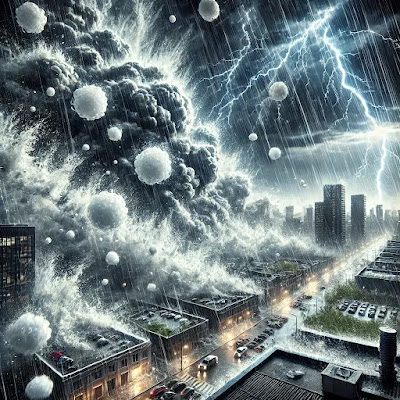Hailstones are one of nature’s most fascinating and sometimes destructive weather phenomena. These frozen spheres of ice can range in size from tiny pellets to massive chunks that cause significant damage to property, agriculture, and even human lives. But how do hailstones form, and what makes them so powerful? Let’s dive into the science and impact of hail.
How Hailstones Form
Hailstones originate within strong thunderstorms that contain intense updrafts, supercooled water droplets, and varying air temperatures. The formation process occurs in several stages:
Supercooled Water Droplets: Within a thunderstorm, water droplets are carried high into the atmosphere where temperatures are below freezing.
Ice Nuclei Formation: The supercooled droplets attach to tiny particles like dust or dirt, forming a small ice pellet.
Updraft Circulation: Powerful updrafts carry the pellet upward, where more supercooled droplets freeze onto it, causing it to grow.
Layered Growth: As the hailstone moves up and down within the storm cloud, it accumulates additional layers of ice, much like rings in a tree.
Final Descent: When the hailstone becomes too heavy for the updrafts to support, it falls to the ground as hail.
Hailstone Sizes and Their Impact
Pea-sized (0.25 inches): Typically harmless, though they can be noisy.
Marble-sized (0.5 inches): May cause minor damage to crops and flowers.
Golf ball-sized (1.75 inches): Can dent cars, break windows, and injure animals.
Baseball-sized (2.75 inches) or larger: Capable of severe damage, including destroying roofs and injuring people.
The Dangers of Hailstorms
Hailstorms are responsible for billions of dollars in damage every year, especially in regions prone to severe thunderstorms. Their effects include:
Agricultural Devastation: Crops such as wheat, corn, and fruit-bearing trees can be completely ruined within minutes.
Property Damage: Roofs, vehicles, and glass structures are highly vulnerable to large hail.
Personal Injury: Hailstones can cause bruises, fractures, and even fatalities in extreme cases.
Regions Prone to Hailstorms
Hail can occur anywhere thunderstorms develop, but some regions experience more frequent and severe hailstorms. These include:
Hail Alley (USA): States like Texas, Oklahoma, Kansas, and Nebraska see some of the highest occurrences of hail in the world.
Northern India and Bangladesh: Frequent monsoon thunderstorms produce intense hail events.
Parts of China and Australia: Some areas experience extreme hail due to strong convective storms.
Protecting Yourself and Your Property from Hail
To minimize hail damage and stay safe during a storm, consider these precautions:
Stay Indoors: If a hailstorm is approaching, seek shelter immediately to avoid injury.
Protect Vehicles: Park cars in a garage or under a sturdy cover when storms are forecasted.
Use Impact-Resistant Roofing: Modern hail-resistant materials can significantly reduce damage to buildings.
Monitor Weather Alerts: Pay attention to storm warnings and be prepared to take action.
Conclusion
Hailstones, while mesmerizing in their formation, are a powerful force of nature that can lead to severe destruction. Understanding how they form, where they occur, and how to protect against them can help mitigate their impact. Next time a thunderstorm rolls in, keep an eye out for the telltale signs of hail—it’s a reminder of the incredible forces at play in our atmosphere.

Comments
Post a Comment